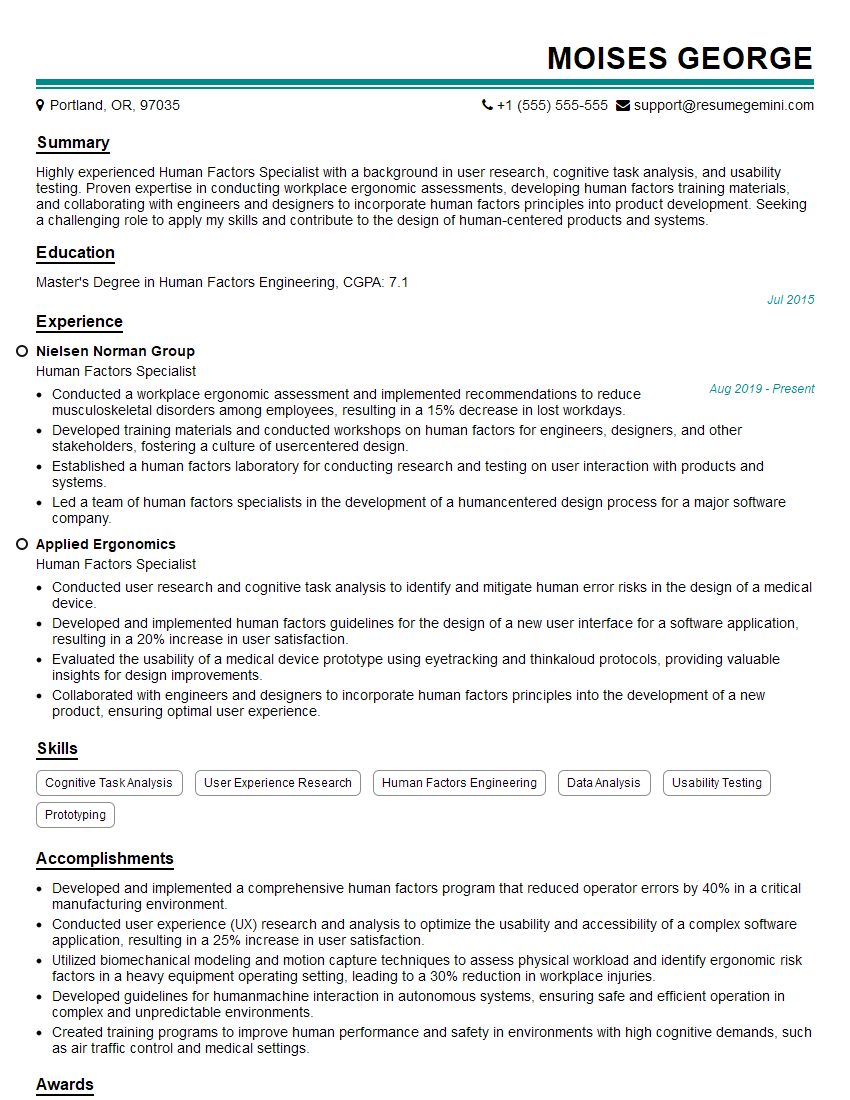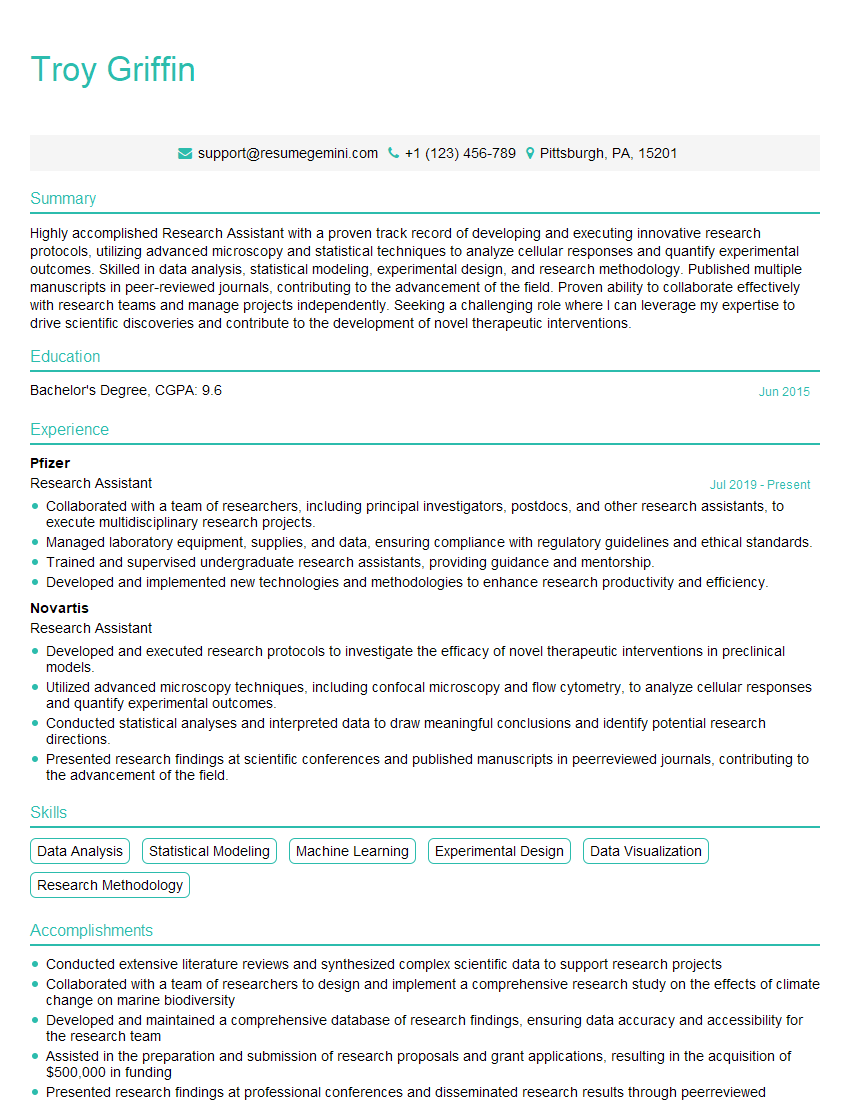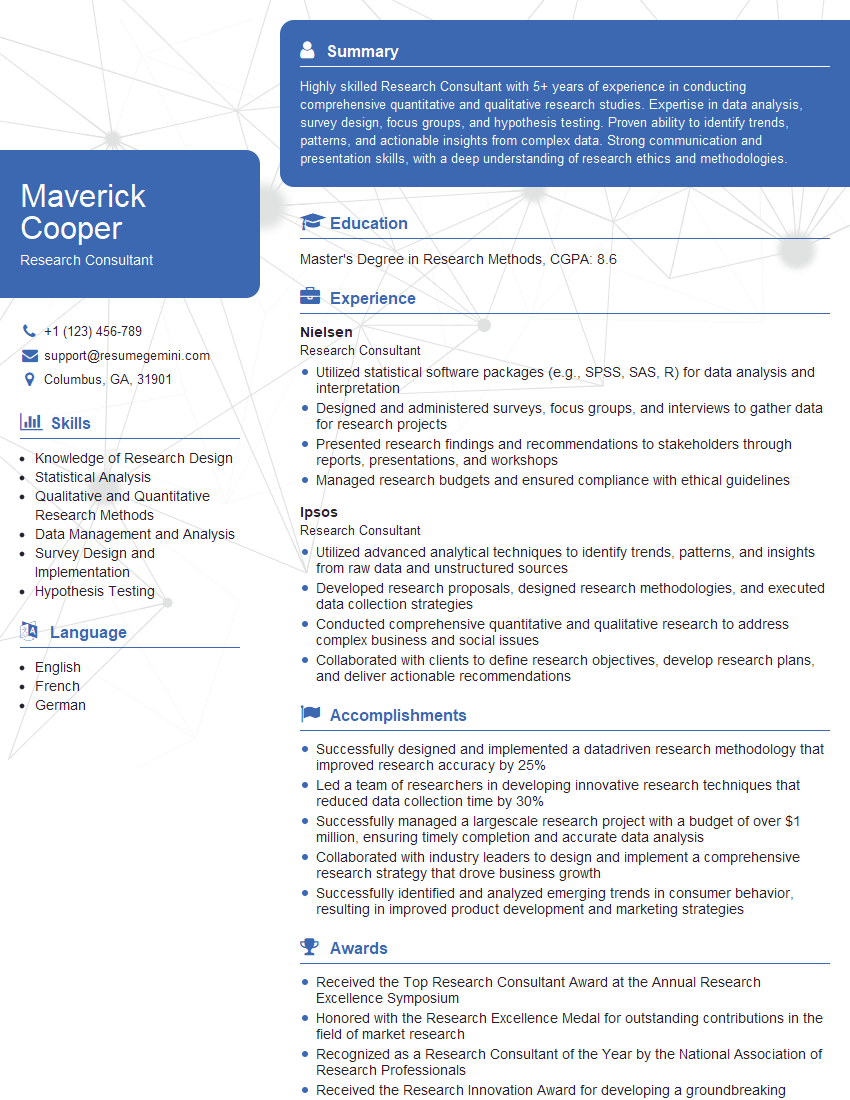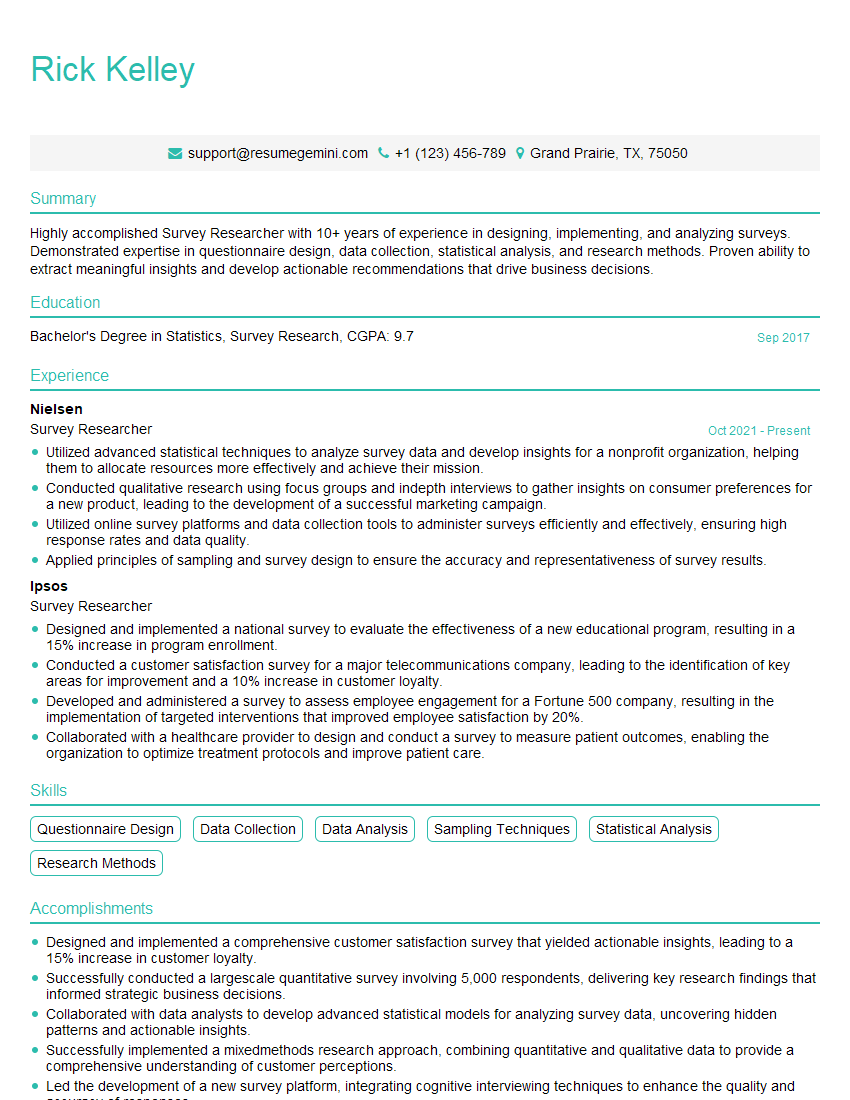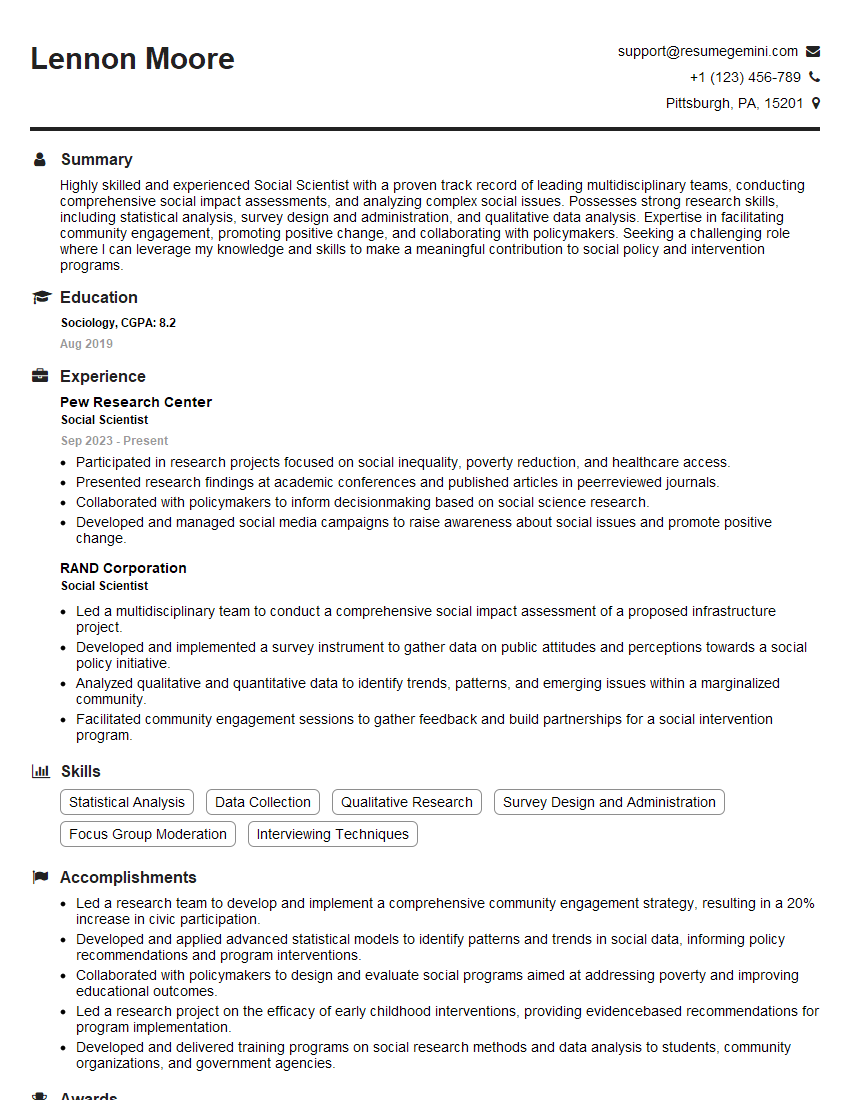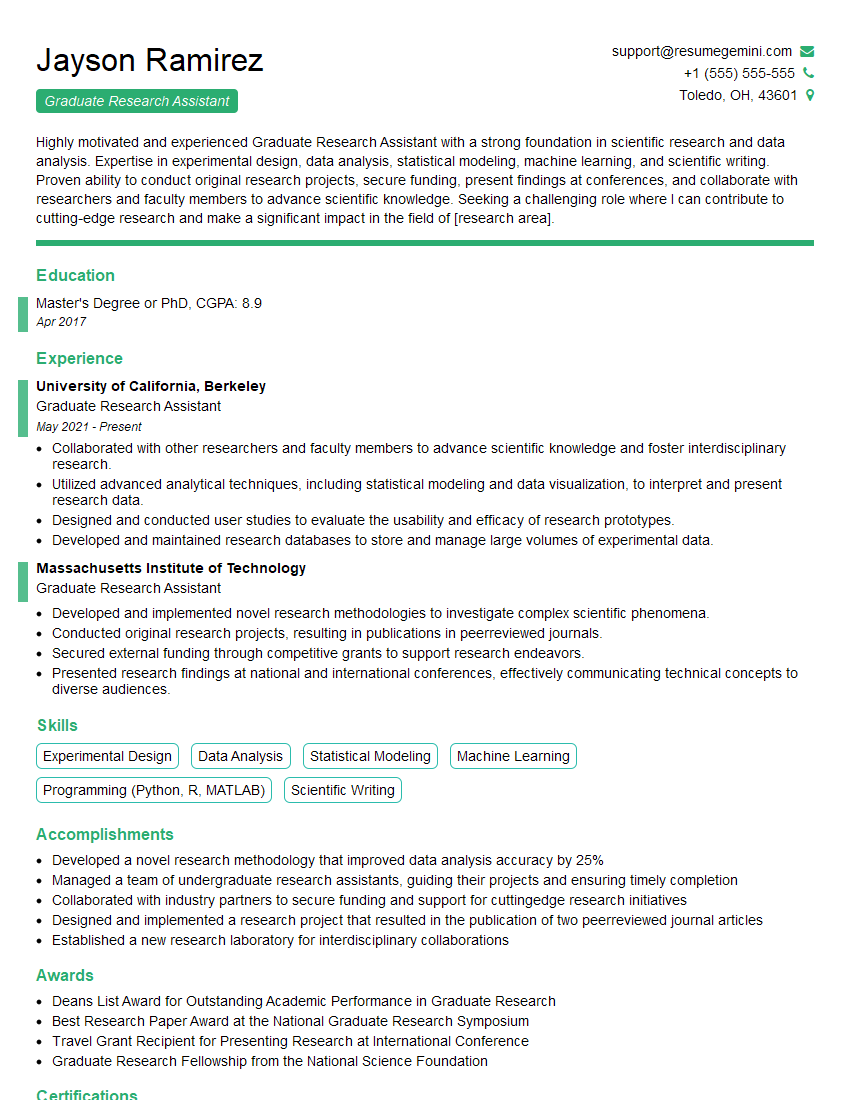Are you ready to stand out in your next interview? Understanding and preparing for NVivo (Qualitative Data Analysis Software) interview questions is a game-changer. In this blog, we’ve compiled key questions and expert advice to help you showcase your skills with confidence and precision. Let’s get started on your journey to acing the interview.
Questions Asked in NVivo (Qualitative Data Analysis Software) Interview
Q 1. Explain the difference between grounded theory and thematic analysis within NVivo.
Both grounded theory and thematic analysis are qualitative research methods used to analyze data in NVivo, but they differ significantly in their approach. Grounded theory is an inductive approach where the theory emerges from the data itself. You start with the data and let the patterns and concepts emerge organically, iteratively refining your codes and categories as you analyze more data. It’s like building a house from the ground up, brick by brick, without a pre-existing blueprint. Thematic analysis, on the other hand, is often more deductive. While you might start with some pre-conceived notions or research questions, you identify recurring themes or patterns within your data to answer those questions. It’s more like having a blueprint (research questions) and using your data to fill in the details and potentially revise the blueprint based on what you uncover. In NVivo, both methods involve coding and categorizing data, but grounded theory emphasizes constant comparison and iterative refinement, whereas thematic analysis might involve a more structured approach with pre-defined themes or codes.
For example, if you’re studying customer feedback on a new product, grounded theory might lead you to discover entirely unexpected aspects of customer experience that weren’t in your initial research questions, whereas a thematic analysis might focus on pre-defined themes like ‘product features’, ‘customer service’, and ‘pricing’. NVivo facilitates both approaches by allowing flexible coding and the creation of hierarchical node structures to represent emerging theories or themes.
Q 2. Describe your experience with coding and categorizing data in NVivo.
My experience with coding and categorizing data in NVivo is extensive. I’ve worked with diverse datasets ranging from interview transcripts and focus group discussions to social media posts and news articles. My coding approach is meticulous and iterative. I typically start with open coding, assigning initial codes to segments of text based on their apparent meaning. Then, I move to axial coding, organizing these codes into categories and subcategories, looking for relationships and patterns. I leverage NVivo’s features to make this process efficient, such as its ability to create hierarchical nodes, search for specific words or phrases across the entire dataset, and visualize relationships between codes using the network view. For instance, in a project analyzing public opinion about climate change, I might initially code segments of text with codes like ‘concern about sea-level rise’, ‘support for renewable energy’, or ‘skepticism about climate science’. Then, through axial coding, I would organize these under broader categories like ‘environmental impact’, ‘policy preferences’, and ‘beliefs about climate change’. This helps reveal underlying structures and patterns within the data.
Q 3. How would you handle large datasets in NVivo to maintain efficiency?
Handling large datasets in NVivo efficiently requires a strategic approach. Firstly, effective data import is crucial. NVivo allows for importing data in various formats, ensuring data integrity during import. Next, I’d utilize NVivo’s query features strategically to avoid processing unnecessary data. For example, using filters and Boolean queries allows working with only relevant subsets of the data. Regular data backups prevent loss due to unforeseen issues. When coding, I might divide the data among team members or use a phased approach, focusing on a manageable portion before expanding. Using a well-defined and consistent coding framework ensures accurate and efficient coding. I also exploit NVivo’s visualization tools to monitor progress and identify areas needing further attention. For instance, if I’m working with thousands of social media posts, I might initially query only those containing specific keywords relevant to my research question. Then, after an initial code structure is developed, I can apply more precise filters and searches to refine my analysis.
Q 4. What are the different types of queries you can use in NVivo?
NVivo offers a powerful array of query types to explore your data. These include:
- Word Queries: Searching for specific words or phrases. For example, finding all mentions of ‘climate change’.
- Boolean Queries: Combining multiple search terms using AND, OR, and NOT operators for more precise results. For example, finding mentions of ‘climate change’ AND ‘renewable energy’ but NOT ‘fossil fuels’.
- Wildcard Queries: Searching for words with similar spellings or variations. For example, using ‘*’ to find ‘chang*’ would return ‘change’, ‘changes’, ‘changing’, etc.
- Proximity Queries: Finding words that appear within a specified distance of each other. Useful for identifying contextual relationships.
- Node Queries: Searching within specific nodes or categories you’ve created. This allows for focused analysis within segments of your data.
- Matrix Queries: Creating matrices to explore relationships between nodes or codes (discussed further below).
The choice of query type depends on the specific research question and the structure of the data. NVivo’s query builder makes it straightforward to combine these types for sophisticated analysis.
Q 5. How do you manage and resolve coding discrepancies within a team using NVivo?
Managing coding discrepancies within a team in NVivo requires careful planning and communication. We establish clear coding guidelines and a shared coding framework before beginning. Regular team meetings are crucial to discuss coding interpretations and resolve discrepancies. NVivo’s features, like the ability to review coding decisions, are invaluable in this process. We could use NVivo’s ‘review coding’ to compare individual coder’s coding of the same data segment. To resolve discrepancies, we aim for consensus through discussion and referencing the coding framework. Sometimes, minor adjustments to the coding framework might be necessary based on the emerging patterns in the data. Using a collaborative approach fosters consistency and improves the validity of the results. For example, if one coder consistently codes a certain phrase under a different node than the others, this suggests a need to clarify the definition of that node or adjust the framework accordingly.
Q 6. Describe your experience using NVivo’s matrix coding.
My experience with NVivo’s matrix coding is extensive. Matrix coding is incredibly useful for exploring relationships between variables in qualitative data. You create a matrix where the rows represent one set of codes and the columns another. The cells then show the frequency of cases where both codes occur together. For instance, in a study on leadership styles, you might have one set of codes representing leadership behaviours (e.g., ‘autocratic’, ‘democratic’, ‘laissez-faire’) and another representing outcomes (e.g., ‘high employee morale’, ‘low employee turnover’, ‘high productivity’). The matrix would then reveal how different leadership styles are associated with different outcomes. It allows for visualizing patterns and trends, supporting more insightful interpretations. It’s similar to creating a cross-tabulation in quantitative analysis, but applicable to qualitative data.
Q 7. Explain your approach to building a robust coding framework in NVivo.
Building a robust coding framework in NVivo is paramount for a successful analysis. I start by defining the research questions and objectives clearly. This helps guide the initial development of the codes. I often conduct pilot coding on a smaller sample of data to identify potential issues with the initial framework. This iterative approach allows for adjustments and refinements before applying it to the entire dataset. The framework needs to be flexible and adaptable, allowing for the emergence of new codes or categories as the analysis progresses. Using hierarchical coding structures in NVivo (parent nodes and child nodes) helps organize codes in a clear and logical manner. I also use memos extensively to document the rationale for coding decisions and any insights that emerge during the analysis. A well-documented coding framework not only ensures consistency but also ensures transparency and reproducibility of the analysis for future review or collaboration.
Q 8. How do you ensure the reliability and validity of your NVivo analysis?
Ensuring reliability and validity in NVivo analysis is crucial for producing credible research. Reliability refers to the consistency of the findings, while validity ensures that the analysis accurately reflects the data and the research question. I achieve this through a multi-pronged approach:
- Detailed Audit Trail: I meticulously document every step of my analysis, including coding schemes, queries, and interpretations. This allows for scrutiny and replication by others.
- Inter-coder Reliability Checks: When feasible, I involve other researchers in the coding process to assess inter-rater agreement, using measures like Cohen’s Kappa to quantify consistency. Differences in coding are discussed and resolved through consensus, ensuring a shared understanding.
- Triangulation: I often use multiple data sources (e.g., interviews, observations, documents) to corroborate findings and strengthen the validity of interpretations. For example, if an emerging theme from interviews is supported by similar patterns in field notes, this strengthens the theme’s validity.
- Member Checking: When appropriate, I share my findings with participants to validate interpretations and ensure they align with their perspectives. This is particularly useful in qualitative research, where participant feedback can significantly refine the analysis.
- Reflexivity: I acknowledge my own biases and perspectives, which might influence the analysis. By documenting this self-reflection, I encourage critical evaluation of my interpretations.
Think of it like building a sturdy house: each method is a structural element contributing to the overall strength and trustworthiness of the research. By combining these methods, I build a robust, credible study that stands up to scrutiny.
Q 9. How familiar are you with NVivo’s functionalities for visualizing data?
I’m highly familiar with NVivo’s visualization capabilities. They are essential for presenting findings in a compelling and easily digestible manner. My go-to visualizations include:
- Word Clouds: Excellent for quickly identifying prominent words and concepts within a dataset. This gives a great overview and immediately showcases the most frequently used terms.
- Networks: These visually represent relationships between codes, nodes, and concepts, highlighting key connections and clusters within the data. This helps uncover complex relationships that might be missed through textual analysis alone. For instance, you can see which concepts frequently appear together.
- Charts and Graphs: NVivo allows for the generation of various charts, such as bar graphs and pie charts, showing the frequency of codes, allowing for an immediate visual comparison of different categories or themes.
- Matrices: I use these to examine the co-occurrence of codes across different data sources. For example, you can visualize how a particular code appears across different interview transcripts or documents.
Each visualization serves a distinct purpose. Selecting the appropriate method hinges on the specific research question and the insights to be conveyed. I always ensure that any visualization is accompanied by a clear explanation of the context and interpretation.
Q 10. What are your preferred methods for exporting data from NVivo?
My choice of exporting data from NVivo depends heavily on the intended use. Here are some of my preferred methods:
- Rich Text Format (RTF): Ideal for exporting coded text segments, preserving formatting and coding information. This is great for reports and publications where maintaining the original structure is important.
- Comma Separated Values (CSV): I use CSV for exporting quantitative data, such as code frequencies or matrix data, for analysis in statistical software packages like SPSS or R. It’s perfect when you need to conduct further quantitative analysis on your qualitative data.
- Excel (.xlsx): Similar to CSV, but with the added benefit of Excel’s formatting and visualization tools. This is convenient for smaller datasets and simpler analysis.
- PDF: Suitable for creating reports and presentations that are easily shareable and won’t lose formatting. It ensures consistency across platforms.
- NVivo’s built-in reporting features: These create professional reports that integrate text, tables, and visualizations from the project. This streamlines the reporting process, avoiding the need for manual assembling.
The key is to select the export format that best preserves data integrity and facilitates further analysis or dissemination.
Q 11. How would you use NVivo to identify patterns and themes within interview transcripts?
Identifying patterns and themes in interview transcripts using NVivo is a systematic process. I typically follow these steps:
- Import Transcripts: First, I import the interview transcripts into NVivo.
- Initial Coding: I begin by open coding, assigning initial codes to segments of text that represent key concepts or ideas. This is an iterative process, refining codes as I become more familiar with the data.
- Code Refinement: I review the codes, grouping similar ones into broader categories or themes. This step is where the patterns start to emerge. I use NVivo’s tools for managing codes and creating code hierarchies.
- Querying and Searching: I employ NVivo’s query functions to search for specific words, codes, or combinations of codes to identify relationships and patterns. This can reveal unexpected connections between themes.
- Visualizations: I use NVivo’s visualization tools (mentioned in a previous answer) to explore relationships between codes and identify prominent themes. This makes the process easier to analyze and understand.
- Theme Development: Finally, I refine themes based on the identified patterns. I often write memos to document my reasoning and justifications for the chosen themes.
For example, if I’m analyzing interviews about customer satisfaction, initial codes might be ‘price’, ‘quality’, ‘service’. Through further coding and querying, I might discover a theme of ‘value for money’ that encompasses aspects of price and quality.
Q 12. Explain your experience with using NVivo’s memoing feature.
The memoing feature in NVivo is invaluable. I use it extensively for documenting my thoughts, interpretations, and decisions throughout the analysis process. Memos serve as a personal audit trail and a space for reflection. My uses include:
- Coding Rationale: I write memos to explain my reasoning behind assigning specific codes to particular data segments. This ensures consistency and allows for future review.
- Interpretative Notes: I record my initial interpretations of emerging themes and patterns. Memos help contextualize observations and track my thinking.
- Methodological Notes: I document my analysis choices (e.g., why I chose a particular coding scheme or query). This is especially important for ensuring the reproducibility of the analysis.
- Ideas and Hypotheses: Memos are a great place to jot down preliminary ideas, hypotheses, or research questions as they arise during the analysis. They form a starting point for further investigation.
- Connecting Data: I create memos to link different data points or codes that appear to be related but aren’t directly connected in the software, facilitating cross-referencing.
Think of memos as an intellectual journal that records the evolution of your understanding throughout the research project. They’re crucial for ensuring transparency, traceability, and the validity of the final findings.
Q 13. How would you approach data cleaning and preparation in NVivo?
Data cleaning and preparation are crucial before any meaningful analysis. In NVivo, this involves several steps:
- Data Import and Review: I begin by carefully reviewing imported data, checking for any errors or inconsistencies in formatting. This might involve removing irrelevant information or correcting typos.
- Handling Missing Data: I consider how to address any missing data (e.g., incomplete transcripts). I might choose to exclude cases with significant missing data, or to impute missing values (where appropriate).
- Data Transformation: Sometimes, data might require transformation to be suitable for analysis. For example, I might anonymize sensitive information or standardize the format of different data sources.
- Noise Reduction: I remove extraneous characters or irrelevant information, like repetitive phrases or unrelated elements that can skew analysis results.
- Data Standardization: I use functions to ensure the data is consistent, such as standardized spellings or capitalization. This is important when searching for specific terms.
Thorough data cleaning ensures that the subsequent analysis is accurate and reliable. It is the foundation of a quality analysis. Imagine building a house: you can’t build a strong house on a poor foundation; similarly, you can’t achieve high-quality research if the data isn’t prepared appropriately.
Q 14. Describe your experience working with different data types within NVivo (e.g., text, audio, video).
NVivo’s strength lies in its ability to handle diverse data types. My experience includes working with:
- Text Data: This is the most common data type. I’ve used NVivo to analyze interview transcripts, survey responses, focus group discussions, and documents of all kinds. The software’s features like coding, querying, and memoing greatly assist in analysis.
- Audio Data: I’ve imported audio files, transcribing them directly within NVivo or importing pre-existing transcripts. This allows for linking coded segments to specific points in the audio file for easy review.
- Video Data: Similar to audio, I’ve worked with video files, linking codes to specific time points within the video. This provides a richer qualitative understanding as it’s easier to contextualize coded segments with their visual components.
- Images: While less common in my projects, NVivo allows for the import of images, which can be coded and analyzed within the same project. This can be beneficial in visual-based research like ethnography.
- Spreadsheets: NVivo seamlessly integrates with spreadsheet data allowing to connect qualitative data with quantitative data to build more robust understandings.
The ability to integrate different data types within a single project enhances the richness and depth of the analysis, fostering a more holistic understanding of the research question. This integrated approach helps to create richer interpretations by correlating the different datasets.
Q 15. How would you handle missing data in your NVivo analysis?
Missing data is a common challenge in qualitative research. In NVivo, handling it involves acknowledging its presence and considering its potential impact on your analysis. There isn’t a single ‘fix,’ but rather a strategic approach.
- Document the Missing Data: First, meticulously document *why* data is missing. Is it due to participant non-response, data loss, or other factors? This understanding is crucial for interpreting your findings. For instance, if a key demographic group has low representation, you’ll need to acknowledge this limitation in your report.
- Qualitative Analysis Techniques: NVivo allows you to analyze what *is* present. Focus on rich descriptions and patterns within your existing data. Missing data might highlight a gap in your sampling strategy, or a theme that needs further investigation in future research.
- Reflexivity: Critically reflect on how the missing data affects your interpretations. For example, if interviews with a particular subgroup are missing, you might acknowledge that your findings may not generalize fully to that group.
- Data Visualization: NVivo’s visualization tools can help illustrate the extent of missing data and its potential influence on your interpretations. For instance, a network map could show which nodes (concepts, themes) are less interconnected due to missing data.
Essentially, the goal is transparency. Don’t ignore the missing data; instead, acknowledge its presence and discuss its implications on your conclusions. This approach ensures rigor and responsible reporting.
Career Expert Tips:
- Ace those interviews! Prepare effectively by reviewing the Top 50 Most Common Interview Questions on ResumeGemini.
- Navigate your job search with confidence! Explore a wide range of Career Tips on ResumeGemini. Learn about common challenges and recommendations to overcome them.
- Craft the perfect resume! Master the Art of Resume Writing with ResumeGemini’s guide. Showcase your unique qualifications and achievements effectively.
- Don’t miss out on holiday savings! Build your dream resume with ResumeGemini’s ATS optimized templates.
Q 16. What are the advantages and disadvantages of using NVivo for qualitative data analysis?
NVivo is a powerful tool, but like any software, it has its strengths and weaknesses.
Advantages:
- Organization & Management: NVivo excels at managing large datasets. It allows you to organize your data (interviews, documents, images etc.), code it systematically, and retrieve information efficiently. Think of it as a highly organized digital filing cabinet for your research.
- Coding & Querying: Its coding features enable detailed analysis. You can create various types of codes, link them to data segments, and perform powerful queries to identify patterns and relationships within your data. It’s like having a sophisticated search engine tailored to your qualitative data.
- Collaboration: Facilitates collaborative research. Multiple researchers can access and work on a project simultaneously. This is particularly beneficial for large-scale projects.
- Visualizations: Provides various visualization options such as word clouds, network diagrams, and matrices, allowing for compelling presentations of findings.
Disadvantages:
- Cost: NVivo can be expensive, which might be a barrier for some researchers.
- Steep Learning Curve: It takes time and effort to master all its features. The initial learning curve can be quite demanding.
- Software Dependence: Your analysis is tied to the software. Migrating data to other platforms might be challenging.
Ultimately, NVivo’s advantages outweigh its disadvantages for researchers dealing with large and complex qualitative datasets where meticulous organization, coding, and collaboration are essential.
Q 17. Compare and contrast NVivo with other qualitative data analysis software.
NVivo is not alone; several other qualitative data analysis software packages exist, each with its strengths and weaknesses. Here’s a comparison:
- NVivo vs. Atlas.ti: Both are powerful programs for managing and analyzing qualitative data. NVivo often has a slightly steeper learning curve, while Atlas.ti is known for its user-friendly interface and strong support for mixed methods. NVivo shines in its robust querying and collaboration features.
- NVivo vs. MAXQDA: MAXQDA is another comprehensive software package. Similar to NVivo, it offers a wide range of functionalities, including coding, querying, and visualization. The choice often comes down to personal preference and the specific requirements of a research project. Some researchers find one software’s interface more intuitive than the other.
- NVivo vs. Dedoose: Dedoose is a cloud-based solution, offering advantages in terms of accessibility and collaboration. NVivo, being desktop-based, might offer more control over data management and offline use. Dedoose may be preferable for projects emphasizing rapid team collaboration.
The best choice depends on your budget, technical skills, project size, and specific research needs. Each software has its niche and provides valuable tools for qualitative research. Consider trying free trials or demos to explore their functionalities before making a decision.
Q 18. How do you ensure the ethical considerations are addressed in your NVivo analysis?
Ethical considerations are paramount in qualitative research. In NVivo, this translates into responsible data management and transparent reporting.
- Anonymization & Confidentiality: Before importing data into NVivo, ensure all identifying information is removed or anonymized. NVivo itself offers features to help manage pseudonyms and protect sensitive data. Think of it like securing a confidential file cabinet.
- Informed Consent: Participants should provide informed consent, clearly outlining how their data will be used and protected. This process should be documented carefully.
- Data Security: Implement robust security measures to prevent unauthorized access to your data. This might include password protection, data encryption, and secure storage practices.
- Transparency in Reporting: Clearly state your data collection and analysis methods in your research reports. Transparency in your methodology ensures accountability and strengthens the credibility of your findings.
- Reflexivity: Be mindful of your own biases and how they might influence your analysis. Documenting your own position and reflective thoughts helps ensure a more ethical and rigorous research approach.
By proactively addressing these ethical considerations throughout the research process – from data collection to reporting – you demonstrate responsible and ethical conduct as a researcher.
Q 19. Explain your understanding of inter-coder reliability and how it is assessed in NVivo.
Inter-coder reliability refers to the extent to which different coders agree on the coding of the same data. It’s a crucial measure of the objectivity and validity of your qualitative analysis. In NVivo, this is assessed through several methods:
- Comparing Coding Schemes: If multiple researchers are involved in coding, NVivo allows you to compare the coding schemes applied by each researcher. This helps identify areas of agreement and disagreement. Think of it as a quality check on your team’s interpretations.
- Using Inter-Coder Reliability Statistics: NVivo can calculate various statistical measures to quantify the agreement between coders, such as Cohen’s Kappa or Krippendorff’s alpha. These statistics provide a numerical representation of the reliability of the coding process.
- Meeting & Discussion: Regular meetings and discussions between coders are vital. These sessions allow for clarification of coding guidelines, resolution of disagreements, and refinement of the coding scheme. It’s important to have a collaborative approach for consistent interpretations.
- Pilot Testing: A pilot study with a subset of the data helps refine the coding scheme and identify potential areas of disagreement before proceeding with the full dataset. This helps ensure consistency early on.
High inter-coder reliability demonstrates the robustness of your coding scheme and strengthens the validity of your interpretations. Strive for a high level of agreement; if disagreements persist, revisit your coding guidelines and engage in further discussions to resolve discrepancies.
Q 20. How do you create and manage a project in NVivo?
Creating and managing a project in NVivo involves a structured approach:
- Creating a New Project: Start by creating a new project file. You will specify the project name and location. Think of this as creating a new folder to store your entire research.
- Importing Data: Import your qualitative data into NVivo. This could include interviews (transcripts), documents, images, audio, or video files. NVivo supports a wide range of file formats.
- Creating Nodes: Organize your data by creating nodes (codes). These nodes represent themes, concepts, or categories that you identify within your data. Think of these as labels for related pieces of information.
- Coding Data: Code segments of your data by linking them to relevant nodes. This process involves systematically identifying and classifying meaningful units of information within your dataset.
- Using Queries: Use NVivo’s querying features to analyze the coded data. You can perform various searches, retrieve data based on specific criteria, and explore relationships between codes.
- Project Management Features: Utilize NVivo’s project management tools such as the source documents, nodes, and queries to organize your research material efficiently.
Careful project organization within NVivo is key to maintain a structured workflow and ensures that your analysis is both thorough and traceable.
Q 21. How would you use NVivo to collaborate with colleagues on a research project?
NVivo offers several features to facilitate collaboration on research projects:
- Shared Projects: NVivo allows you to create shared projects, enabling multiple researchers to work on the same project simultaneously. This helps foster collaboration and allows for real-time teamwork.
- Version Control: The software tracks changes made by different collaborators, ensuring that you can review revisions and revert to previous versions if needed.
- Secure Access Control: Set access permissions to control which users can view or edit the project. This helps maintain data security and ensures data integrity.
- Regular Meetings: Schedule regular meetings to discuss coding decisions, address inconsistencies, and refine the analysis approach. Open communication and teamwork are critical for successful collaborative research.
- Using NVivo’s Collaboration Features: Leverage NVivo’s annotation features, comments, and other tools to communicate and share insights with your colleagues directly within the software. This streamlines the collaborative process and avoids the confusion of external email communications.
Effective collaboration involves clear communication, well-defined roles, and a systematic approach to data management. NVivo facilitates this process by providing features that support collaborative work practices.
Q 22. Describe a time you used NVivo to solve a complex research problem.
In a recent study on the impact of social media on adolescent mental health, we faced the challenge of analyzing a vast dataset comprising interviews, social media posts, and online forum discussions. The complexity arose from the diverse data types and the need to identify subtle correlations between social media usage patterns and reported mental well-being. Using NVivo, I structured the project by creating nodes representing key themes (e.g., ‘Social Comparison,’ ‘Cyberbullying,’ ‘Self-Esteem’). I then coded relevant segments of the data into these nodes, utilizing NVivo’s powerful query functions to identify relationships and patterns. For example, I used the matrix coding query to analyze the co-occurrence of mentions of ‘cyberbullying’ and specific emotional states. This revealed a significant association between experiencing cyberbullying and heightened feelings of anxiety and depression, a finding not readily apparent through manual analysis. This allowed us to draw much more nuanced conclusions and support the study’s overall findings.
Q 23. Explain how you would approach qualitative data analysis in NVivo if you were given a large dataset with little prior structure.
Approaching a large, unstructured dataset in NVivo requires a phased approach, emphasizing iterative refinement. I would start with exploratory data analysis, importing the data (potentially splitting it into manageable chunks if exceptionally large) and using NVivo’s auto-coding capabilities to identify initial themes. This initial pass allows for a preliminary understanding of the data’s structure and key recurring concepts. Next, I’d create a detailed coding framework, possibly employing a grounded theory approach where codes emerge directly from the data itself. This framework might evolve as I progress through the analysis. I would meticulously code segments of the data, consistently reviewing and refining my coding scheme. Throughout the process, I would leverage NVivo’s search functionality (as detailed in the next answer) to identify relationships and patterns between codes and refine my thematic structure. Regular memo-writing is crucial to document my analytical decisions and maintain a clear audit trail.
Q 24. How do you use NVivo’s search functionality to refine your analysis?
NVivo’s search functionality is invaluable for refining analysis. It’s more than just keyword searching; it allows for complex queries. For example, I regularly use Boolean operators (AND, OR, NOT) to combine search terms, enabling precise identification of specific data segments. "social media" AND "anxiety" would find all segments mentioning both terms. The wildcard character (*) is also extremely useful; anxi* will find ‘anxiety,’ ‘anxious,’ and other variations. Beyond keyword searches, NVivo’s query options, such as the word frequency query, can highlight the most prevalent themes within the dataset. The matrix coding query helps visualize relationships between different codes, uncovering unexpected associations. Using these features iteratively, I progressively refine my understanding of the data and hone in on the most salient aspects of the research problem.
Q 25. How familiar are you with NVivo’s support resources and documentation?
I am very familiar with NVivo’s support resources and documentation. I frequently consult the official NVivo website, utilizing both their tutorials and online help documentation for specific queries. Their forums and user communities are an invaluable resource for troubleshooting problems and finding creative solutions to analytical challenges. I have also taken advantage of their training webinars and workshops, significantly enhancing my proficiency with advanced features and data handling techniques.
Q 26. Describe your experience with importing and exporting data in various formats into and from NVivo.
My experience with importing and exporting data in NVivo is extensive. I’ve worked with a wide array of formats, including text files (.txt), Word documents (.doc, .docx), Excel spreadsheets (.xls, .xlsx), PDF files (.pdf), audio files (.mp3, .wav), and video files (.mp4, .mov). NVivo handles the import process smoothly, often preserving formatting and metadata. Exporting data is equally flexible; I can export coded data in various formats suitable for report generation or further analysis in other software. For example, I can export coded segments as text files for thematic analysis in other software or export coded data tables for statistical analysis. Understanding the nuances of each format and how NVivo handles them is crucial for efficient and accurate data management. I always ensure data integrity checks after import and before export to maintain the reliability of my analysis.
Q 27. How would you explain your NVivo analysis findings to a non-technical audience?
Explaining NVivo findings to a non-technical audience requires clear, concise communication, devoid of technical jargon. Instead of mentioning nodes and queries, I’d focus on the key themes and findings using relatable language and visual aids. For instance, instead of saying ‘the matrix query revealed a strong co-occurrence between code X and code Y,’ I’d say something like, ‘Our analysis showed a clear link between [theme X, explained in plain English] and [theme Y, also explained simply].’ Visualizations such as charts, graphs, and word clouds effectively communicate complex relationships and patterns, making them easily digestible for a non-technical audience. Storytelling also enhances engagement; I’d use illustrative examples from the data to support my findings, making the information more accessible and memorable.
Q 28. What are some limitations of using NVivo for qualitative data analysis?
While NVivo is a powerful tool, it’s not without limitations. One significant constraint is the potential for researcher bias in the coding process. The subjective nature of qualitative coding means that different researchers might interpret the same data differently, leading to varied findings. Another limitation is the software’s cost; the license can be expensive, making it inaccessible for some researchers. Moreover, handling extremely large datasets can be computationally intensive and time-consuming, demanding significant system resources. Finally, NVivo’s functionality is primarily focused on qualitative analysis and may lack features necessary for researchers needing sophisticated quantitative analysis tools.
Key Topics to Learn for NVivo (Qualitative Data Analysis Software) Interview
- Data Import & Management: Understanding various data import methods (e.g., text files, spreadsheets, audio/video transcripts), data cleaning techniques, and effective data organization within NVivo projects. Consider practical examples of handling large datasets and ensuring data integrity.
- Coding & Categorization: Mastering the art of developing robust coding frameworks, applying codes to data segments, and refining your coding scheme iteratively. Explore different coding strategies (e.g., thematic, grounded theory) and their applications in various research contexts.
- Querying & Analysis: Become proficient in using NVivo’s querying tools to explore relationships between codes, identify patterns, and generate visualizations to support your analysis. Practice creating different types of queries (e.g., node comparison, matrix queries) and interpreting the results effectively.
- Visualizations & Reporting: Learn how to generate meaningful visualizations (e.g., word clouds, networks, charts) from your data to communicate your findings clearly. Practice creating professional reports that effectively present your analysis and conclusions.
- Data Validation & Reliability: Understand the importance of ensuring the reliability and validity of your analysis. Explore techniques for checking for biases and ensuring the accuracy of your interpretations.
- Advanced Techniques (for technical interviews): Explore more advanced features such as using Auto-coding, working with different data types (e.g., images, social media data), and performing complex statistical analyses within NVivo.
Next Steps
Mastering NVivo is crucial for career advancement in qualitative research, market research, and social science fields. A strong understanding of this software demonstrates valuable analytical skills and significantly enhances your job prospects. To maximize your chances of landing your dream role, crafting an ATS-friendly resume is essential. ResumeGemini is a trusted resource for building professional, impactful resumes that get noticed by recruiters. They provide examples of resumes tailored to showcase NVivo expertise, giving you a head start in the application process.
Explore more articles
Users Rating of Our Blogs
Share Your Experience
We value your feedback! Please rate our content and share your thoughts (optional).
What Readers Say About Our Blog
This was kind of a unique content I found around the specialized skills. Very helpful questions and good detailed answers.
Very Helpful blog, thank you Interviewgemini team.






